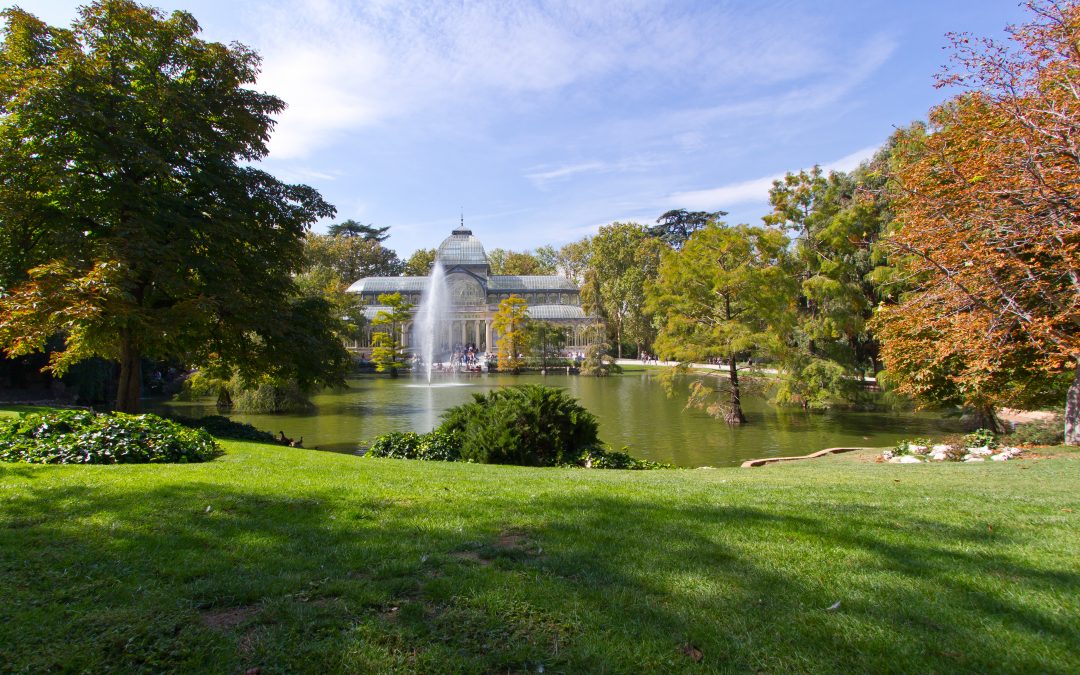Shall we go for a walk?
There’s plenty to choose from!
Madrid offers a green heritage of exceptional size and diversity, more than 6,000 hectares, representing more than 18 square metres of public parks and green areas per inhabitant of the city.
In this link you can consult the list of the main parks and green areas of Madrid classified by District. It includes both gardens and small green areas (plans by district with the locations of these types of parks), as well as those classified as historic, singular or forest parks.
And below, find the most remarkable ones:
Parque El Retiro
Open every day
April-September: 06:00-0:00 h.
October-March 06:00-22:00 h.
Plaza de la Independencia, 7 (main entrance)
125 hectares of green areas with:
- Spectacular gardens such as the “Vivaces” garden, the gardens of Cecilio Rodríguez (classicist gardens with an Andalusian air), the gardens of the Architect Herrero Palacios, the “Rosaleda” (collection of roses) and the French Parterre with the Calvo Cypress, the oldest tree in Madrid, which is said to be around 400 years old.
- Flamboyant architectural and historical elements such as the “Estanque Grande” (it offers various activities, such as rowing boats, boat and solar classroom and the Municipal School of Canoeing), the Palacio de Velázquez and the Palacio de Cristal (one of the main examples of iron architecture in Spain), both of which are currently used as exhibition halls.
- Important sculptures and fountains such as the monument to Alfonso XII (with a viewpoint from which to enjoy beautiful views of the city), the Fernando VII reserve (includes the Fisherman’s House, the Artificial Mountain and the Smuggler’s House – converted into Florida Retiro, a modern multispace dedicated to leisure and restaurants-), the statue of the fallen Angel (the only sculpture in the world that represents the devil), the Galapagos fountain, the Hermitage of San Pelayo and San Isidoro, the Forest of Remembrance and the Puppet Theatre (the only theatre in Europe with a stable programme every weekend).
- Cultural and sports areas such as the La Chopera Municipal Sports Center, the Eugenio Trías Municipal Public Library and the Casa de Vacas Cultural Center.
- Large child playgrounds.
- Extensive areas to practice sports such as running, skating, yoga, taichi, etc..
- Nice kiosks and terraces to rest and have a drink.
- Possibility of renting a bicycle to enjoy the Park on wheels.
The Retiro Park also hosts such emblematic events as the Book Fair and the San Isidro fireworks.
Jardines de Sabatini
Open every day
October-April: 09:00-21:00 h
May-September: 09:00-22:00 h
Calle Bailén, 2 (Entrance)
Located at the foot of the Royal Palace, the park replaces the stables built by Sabatini and included several of the sculptures that were intended to decorate the cornice of the Palace, highlighting its architectural character as an extension of the Royal Palace.
With its classicist style and geometric design, its privileged location, the Sabatini Gardens are one of the most spectacular in Madrid. Especially recommendable to watch the sunset from the large rectangular pond in the center of the park, surrounded by trees, plants, fountains and white marble sculptures and with the Royal Palace and the Casa de Campo as the stage.
Jardines del Campo del Moro
Open every day.
October – March: 10:00-18:00 h
April-September: 10:00-20:00 h
Paseo Virgen del Puerto, s/n (Entrance)
Situated on the rear façade of the Royal Palace, in a great unevenness that contributed to create one of the best views of the Palace to be in an elevated position behind the leafy park.
It was promoted in the nineteenth century by Queen Maria Cristina.
It is an English style garden following the romantic concept of nature with beautiful monumental fountains (Tritones and Palacio de las Conchas) within a large romantic garden.
Parque El Capricho
Open Saturdays, Sundays and holidays only.
Oct-Mar: 9:00-18:30 h
Apr-sept: 9:00-21:00 h
Paseo Alameda de Osuna, 25 (Entrance)
Rules:
Access for animals, even when tied up, is not permitted.
Access with bicycles and skates is not permitted.
You can’t play ball in the Garden
It is not allowed to eat inside the Garden.
Located in Alameda de Osuna, east of Madrid.
It was created in 1784 by the Dukes of Osuna and especially by the Duchess, Doña María Josefa de la Soledad Alonso Pimentel.
The park houses an important botanical, sculptural and artistic wealth. It contains temples, hermitages, fountains, squares and the palace of the dukes (which from 2019 will house on its three floors a museum dedicated to the Duchess of Osuna and the period she represents, the Enlightenment).
The garden offers three different styles: the French parterre or garden, the English landscape and the Italian giardino.
El Capricho conserves in very good condition a bunker from the Civil War period that can be visited by prior reservation.
Here you can download a map.
Casa de Campo
Open all year round for pedestrians.
Closed to private traffic.
The accesses to the Zoo, Amusement Park, Paseo de Extremadura and Lake area are closed from 01:00-06:00 h.
Paseo de Puerta del Angel, 1 (Main entrance)
The Casa de Campo de Madrid was a Royal Site for hunting and recreation of the Monarchy from 1562 to 1931 when it became a public park.
For this reason, in addition to its ecological and landscape value, it has an important historical load with archaeological remains, historical buildings, military constructions from the time of the Civil War as it was a battle front and examples of contemporary architecture from its time as a public park.
It is the largest public park in Madrid, mainly of a forestry nature.
Inside, there are various facilities, such as the Amusement Park, the Casa de Campo Lake, the Zoo, the Cable Car (which connects the Casa de Campo with the Parque del Oeste, on the other side of the Manzanares River), fairgrounds, the Madrid Arena multipurpose pavilion, the Venta del Batán (traditional bullring in the days prior to the bullfight in the Plaza de Toros de Las Ventas) and various popular sports facilities.
Casa de Campo is also one of the parks chosen by lovers of outdoor sports and in summer, its swimming pool is one of the busiest in Madrid.
Fond here a map and a brochure with bicycle routes.
Madrid Río Park
Open all day
Puente de Segovia, s/n
Madrid Río is an enormous recreational and cultural site recently built and parallel to Manzanares River whose main objective is the recovery of the biodiversity of the riverbed.
From a recreational point of view, there are 17 children’s play areas (link map) along the Salon de Pinos with different characteristics depending on age. Among them, the Playa de Madrid Río stands out, which jets of water are ideal to cool down in summer.
There are also spaces for adults such as bio-healthy circuits, petanque courts, games tables and a Manzanares River Interpretation Centre.
From the cultural point of view, there is the possibility of enjoying all the offer of Matadero Madrid (exhibitions, music festivals, plays…) and the visit to the newly built -and beautiful- bridges, such as the monumental bridge of Arganzuela or bridge of Perrault.
In Madrid Rio is the Explanada del Puente del Rey, where the Spanish football team celebrated its victory in the World Cup in South Africa in 2010.
And also the Shopping Center Plaza Rio 2.
Real Jardín Botánico
Open every day of the year, except Christmas and New Year.
Opening hours: 10:00h.
Closing times:
- From nov. to feb.: 18:00h
- Tue and Oct: 19:00h
- Apr and Sept: 20:00h
- From May to Aug: 21:00h
Price
Ordinary ticket (over 10 years old): 4 €.
50% reduction: student card or their international correspondents
Groups (10 or more people): 2 €.
Large families: €2
Over 65s: €0.50
The rules for the use of the garden and guided tours can be found at this link.
Declared an Artistic Garden in 1942, its collections include a herbarium with more than a million leaves, the library and archive, with nearly 10,000 drawings, as well as a sample of 5,000 species of living plants.
The tour of the garden and its greenhouses combines general botanical contents, curiosities, history, singularity of the specimens, uses of the plants and their importance in our lives.
The current location of the Botanical Garden is not casual and responds to the interest of the enlightened monarch, Carlos III, to create a complex in Madrid dedicated to natural sciences. That is why it was located next to what is now the Prado Museum, which at the end of the 18th century was the Museum of Natural Sciences.
The scientific spirit is preserved today as the space is managed by the Consejo Superior de Investigaciones Científicas, which organizes a multitude of activities of an informative nature, such as conferences and exhibitions.
Jardines del Templo of Debod
Open all day.
Ferraz Street, 1
In 1968 Manuel Herrero Palacios designed these 8-hectare gardens, located in the Princesa area, so that the Egyptian Temple of Debod could be installed there and shine in all its splendour.
From here you can contemplate the famous cornice of Manzanares, with the Royal Palace, the Casa de Campo and, possibly, the most beautiful sunsets in Madrid.
The Temple of Debod is funerary in character, more than 2000 years old, was rescued from the waters of the dam of Aswan by a team of Spanish archaeologists, brought stone by stone and rebuilt in its current location after the Egyptian government gave it to Spain. It was installed on the remains of the Mountain Barracks according to the same solar orientation it had in its place of origin.
You can find a map and its history.
Quinta de los Molinos Park
Open every day
Mon-Sun: 6:30-22:00 h
Calle Alcalá, 527
Near the Feria de Madrid and the new Atlético de Madrid stadium is this public garden whose origin is a rustic urban recreational estate with farming areas and a marked Mediterranean character, which has buildings and architectures declared of high interest.
The park includes the Quinta de los Molinos Open Space, a new cultural space designed specifically for children and teenagers and their families.
The park includes large extensions of trees, in which we can find a large number of species (olive trees, pines, eucalyptus), although the star of the park are almond trees, which bloom in February and March, offering a fantastic spectacle.
The park is divided into two clearly differentiated zones: the northern zone with a romantic landscape style and the southern zone with an agricultural character.
Closed in the totality of its perimeter with five doors of access.
Parque del Oeste
Open all day.
Paseo Moret, 2 (main entrance)
Parque del Oeste is located in the district of Moncloa, between Avda. del Arco de la Victoria and Paseo de Pintor Rosales, to the east; the railway line, to the west and Avda. de Séneca, to the north. It’s crossed inside by Paseo de Ruperto Chapí, Paseo de Camoens and C/ Francisco y Jacinto Alcántara.
The northern and oldest part of the park is especially relevant, where its landscape character is accentuated, with an artificial estuary of about 600 m in length running inside.
There is a great variety of plant species, highlighting the unique population of conifers, in contrast to the seasonal development of hardwoods.
You will find the Avifauna Centre where you can contemplate different species of birds.
If you are planning to move to Madrid soon, you’ll find all the relevant information in The secret of relocating to Madrid. If, in addition, you need help with the organization or even if you prefer that we accompany you, check out our services.
In the meantime, you can receive regular information by filling out this questionnaire. And if you find it useful, we thank you for sharing it.



